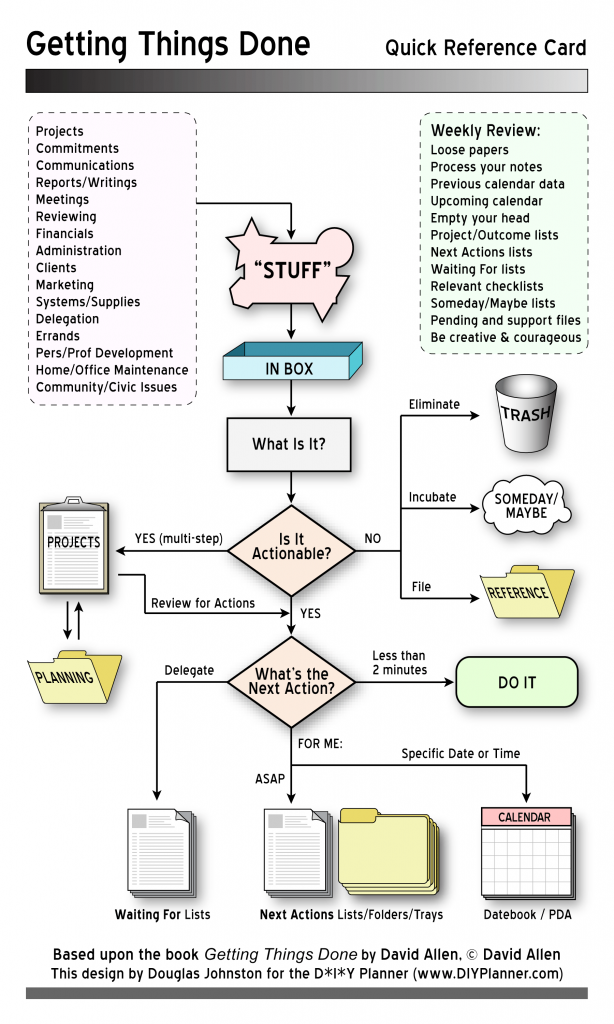
Running your own business is not easy at all. There are lots of things to concentrate on, without losing the focus on the main task you are doing. I’m an entrepreneur since I graduated so I had to find the best practices for scheduling and managing my daily routine. But these productivity habits aren’t only useful for entrepreneurs, everybody can save time with some of them. In the first part I want to introduce everybody into my favourite one: The Getting Things Done Method.
Getting Things Done Method
Getting Things Done (aka GTD), is the Grocery List method on steroids. It is simple enough to get started right away, but as you dig deeper, it can help you on so many levels. Tools, which you can install on your phone, may resemble classic Grocery List apps but they allow you to create sub- lists and manage time you spend on each task.
To not waste anyone’s time, let’s see GTD in 2 minutes:
- Your mind is not meant to remember… tasks. Write down every little task you can think of, so that you can get everything out of your head. This goes to your Inbox.
- Set aside 30 minutes each week (for me it’s Friday afternoon) when you clear your Inbox and put it to Other
- Create the following lists name like (you can add other lists later):
- Inbox: This is where you instantly write down everything. First question is if it is actionable. If there is something that can be done in less then 2 minutes, do it right away. It should be something precise like “Email Peter about XY”.
- Some day: If it is not actionable, you put it to “Some day”. If it stays there for more than let’s say 30 days, you can either delete it to the trash or leave it there.
- Next action: If it is actionable with a simple step (and it takes more than 2 minutes), you put it to “Next action” folder. Here you can decide to do it as the list is, or specify a specific date.
- Waiting for: Works like the “Next action” folder, but this task is out for someone to be competed and you are setting a reminder preferably with a due date.
- Projects: If it is actionable, but has multiple steps, you create a project out of it and define as many small tasks as possible. This is what we call planning. Remember, you always need to have a “Next action” subtask in every project. This is crucial to get things done!
- Grocery: Let’s start with groceries. It can be an ongoing project, since you need to do that. In this project, you can list whatever you will need and just move it here from you Inbox.
That’s it. Simple like that.
Pros: GTD helps you get things out of your mind and never forget anything and get it done in the most effective way.
Cons: You must be very persistent and devoted to your work- you can’t skip days because this would cause even bigger mess instead of helping you to put everything in order. Also, those apps that are supposed to help you sorting tasks, are slightly more complex and can be a bit confusing in the beginning.
How to be a pro in GTD
As time flies, you will create and close many projects and find your own pace. You can add contexts and tags, but that’s not necessary. If you would like to get more into practical application, read this deep guide about GTD, but if you’d like to become a pro, I suggest the holy grail of GTD by the man behind.
After you know everything about the method in theory, let’s see the best apps avaiable for using GTD in practice:
Want to get started now? Take 5 minutes and write everything that is in your head.
It is a very good technique for learning. Schedule the tasks and set goals. The best way to think about is as about habits in general. The more repetitive method you create, the easier it will get to do something. Combine what you have learned so far and use the Pomodoro technique with GTD. Make it something that you can stick to and form to a habit. It is like what Ernst Hemingway said: write 5 pages every day and you will have a book in 3 months. It is even more important if you are part of a project group or study group. Lastly here, setting up expectations on why you are doing something will keep your passion’s drive.
If you have any questions, feel free to contact me!






It is really important to know and learn GTD, it helps you with your daily to-do task and what to prioritize and set aside the not so priority tasks. Thank you for sharing this one.
https://www.gtd.co.nz